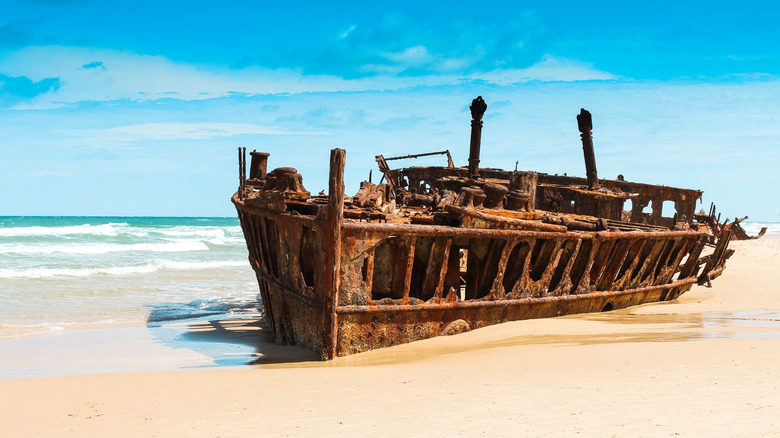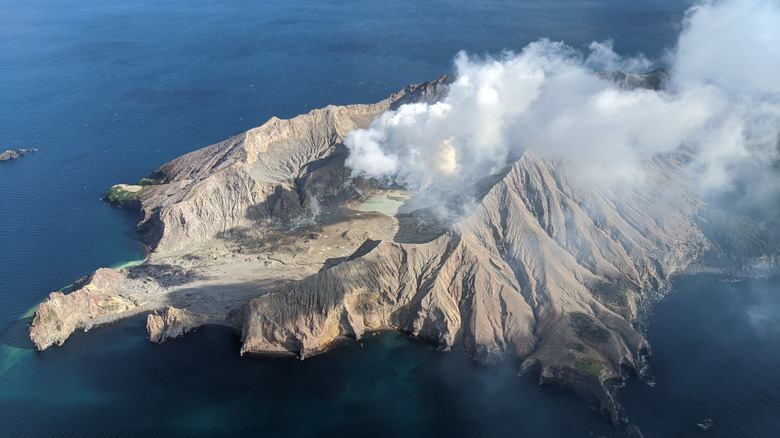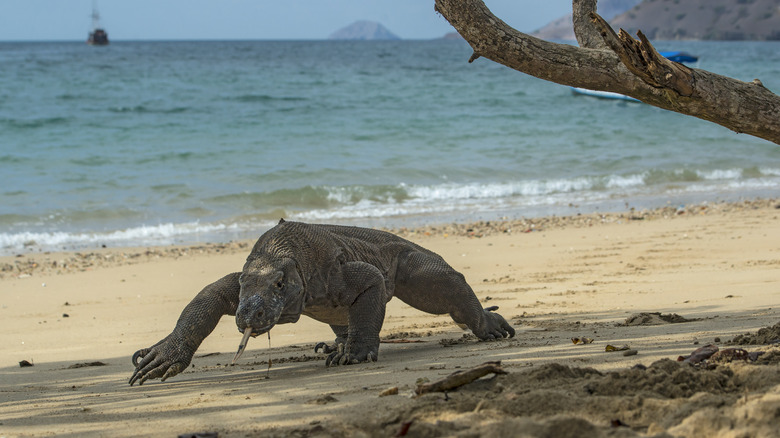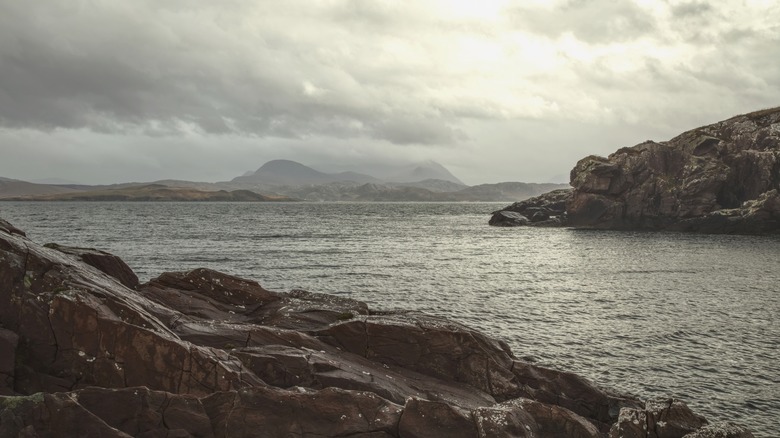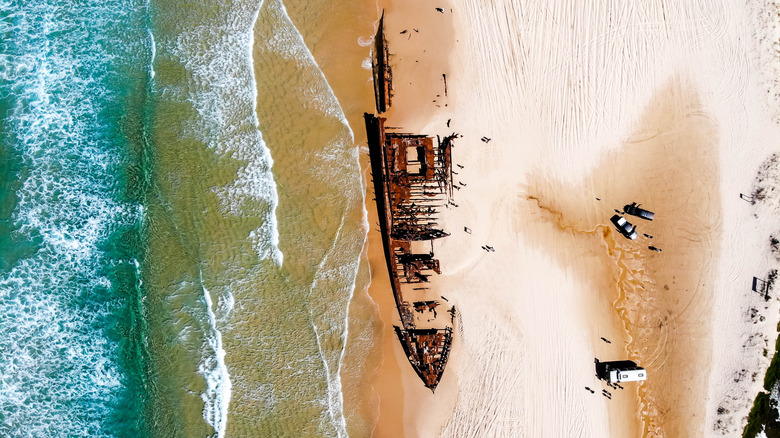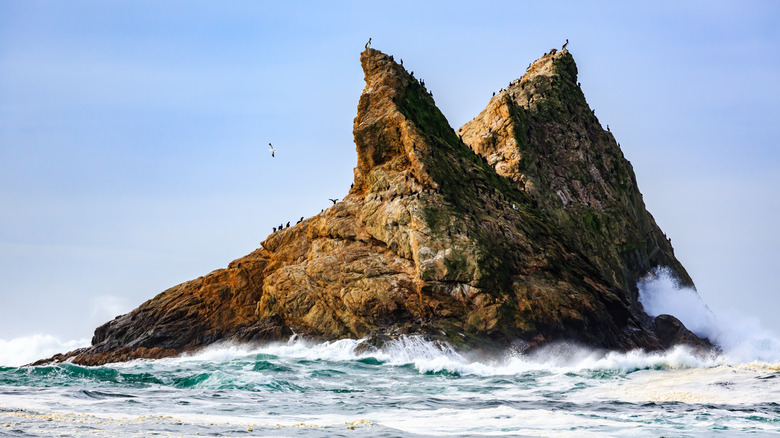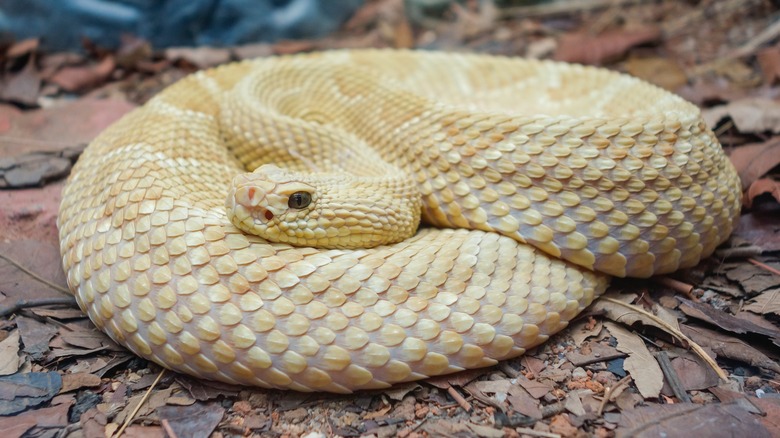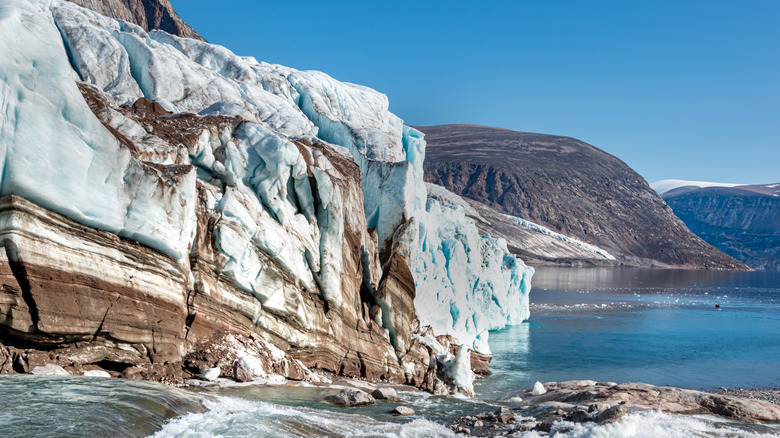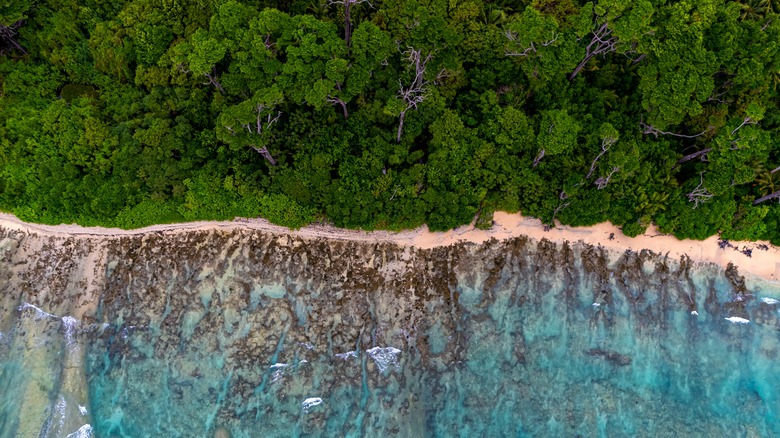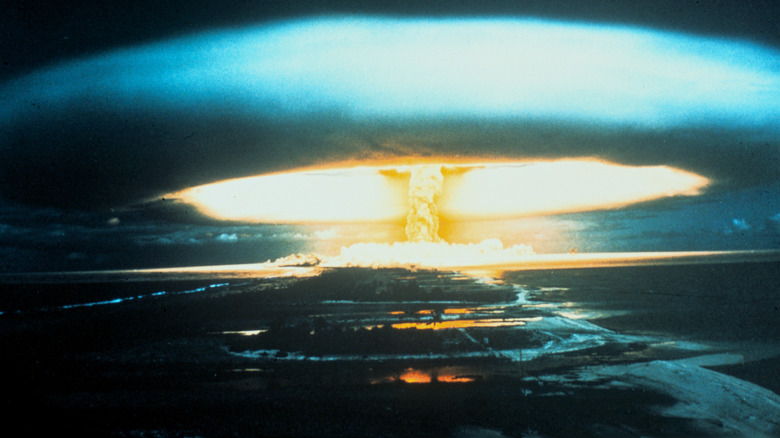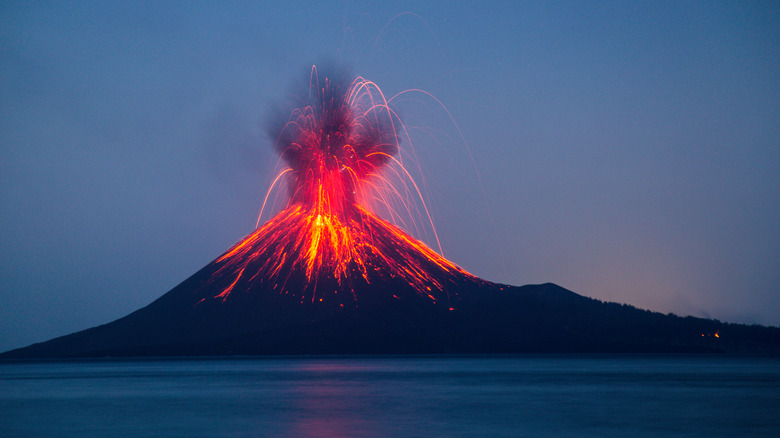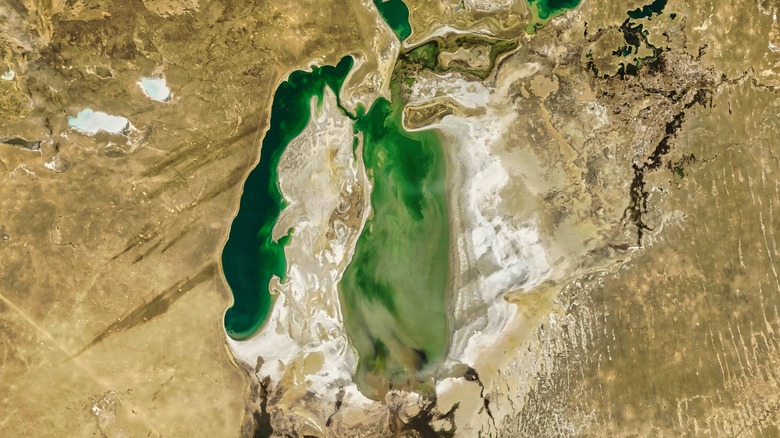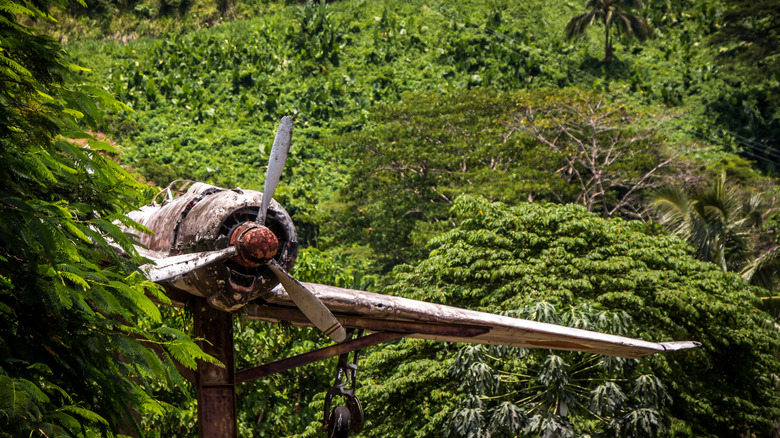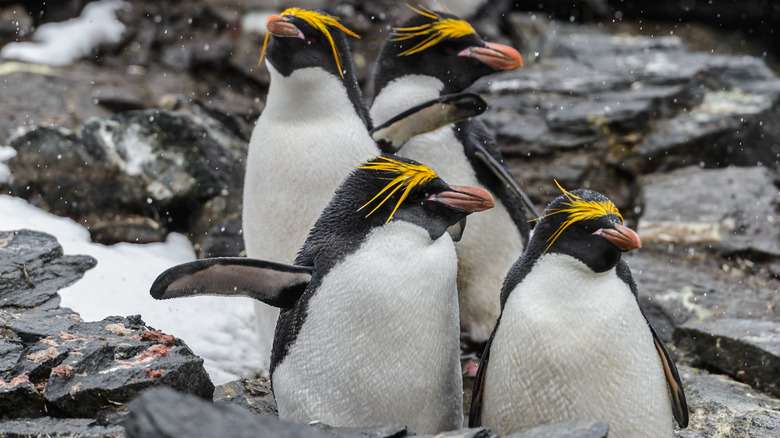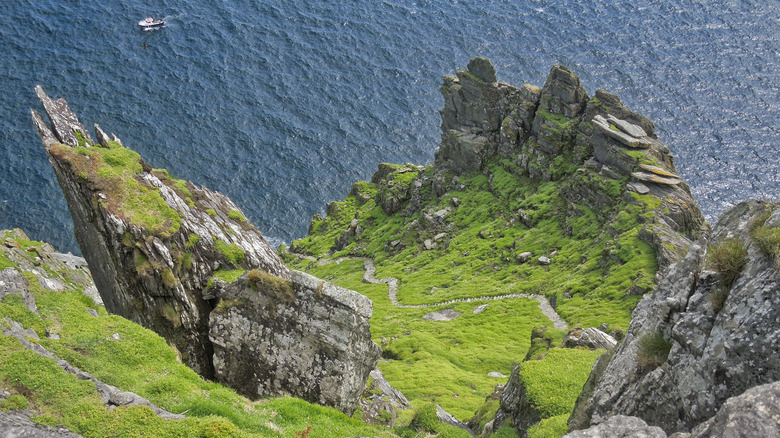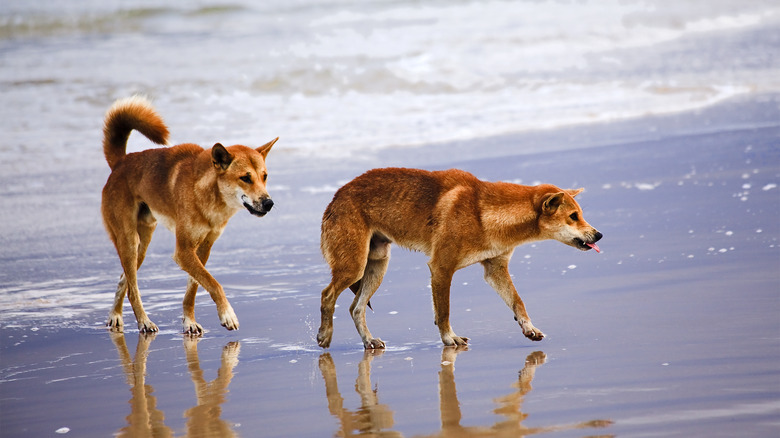14 Most Dangerous Islands In The World
Islands typically bring to mind swaying palm trees, sandy beaches, and laid-back vacation vibes. But not all islands are paradises. Some may look idyllic, but harbor terrifying secrets like poisonous animals or deadly chemicals. Others display more obvious signs of danger like the smoking cones of active volcanoes or craggy cliffs that spill into the sea at sharp angles. Either way, you might want to think twice before visiting these spots, because they're considered some of the most dangerous islands in the world.
If you're planning an island getaway where you can relax on a beach and do some sightseeing, these destinations are not exactly bucket-list material. Each one has a very high-risk factor for travelers, whether that be an inhospitable environment, ferocious wildlife, or man-made hazards. Some of the islands on this list are off-limits altogether, as the governments in their respective countries have declared them too dangerous for the general public. Others are possible to visit, but you'll need to come well-prepared and aware of the potential perils.
Whakaari (White Island), New Zealand
As you approach Whakaari in the Bay of Plenty, it makes for a pretty impressive site. Rugged cliffs rise over 1,000 feet above sea level, and on most days, wisps of smoke waft from the center of the island into the skies above. What you see is only the tip of a massive stratovolcano that is mostly submerged. The complete Māori name is Te Puia o Whakaari, which translates to "The Dramatic Volcano," a fitting moniker considering this is New Zealand's most active volcano.
Tour guides used to take people onto the island to explore the trails around the crater, but that all changed on December 9, 2019. That morning, a massive eruption took the lives of 22 people who were exploring the island. Twenty-five more people were injured. Today, you can only see the island on boat trips or plane tours. It makes for a thrilling adventure in New Zealand, but just know that the volcano can blow at any time. You might be better off catching glimpses of it from lookout points in Whakatāne on the North Island, which is about 30 miles away.
Komodo Island, Indonesia
Komodo Island is home to the largest lizards on the planet: the fierce Komodo dragons. These massive monitor lizards are only found on Komodo and a few other islands in the Komodo National Park in Indonesia. Incredibly aggressive and impressively agile for their size, the lizards have razor-sharp teeth and venomous saliva. They can grow up to 10 feet long and have forked tongues that they use to test the air and smell out prey. They feed on animals like monkeys, deer, wild boar, and goats, but have also been known to attack humans.
You can visit the islands in Komodo National Park on tours that set off from Labuan Bajo on the island of Flores. The boat tours typically take you to Rinca or Komodo Island, where a guide will take you around the island to see the Komodo dragons. Be sure to follow your guide's instructions to the tee. Don't wander off on your own, and keep a very healthy distance from the lizards. Rangers patrol the islands to make sure tourists don't get too close to the dragons, but even so, numerous people have found themselves in the jaws of dragons over the years.
Gruinard Island, Scotland, U.K.
Tiny Gruinard Island is located just offshore the west coast of Scotland, but it's not the kind of place you want to stop by on a boating excursion. During World War II, scientists carried out biological warfare experiments on the island that had lasting repercussions. Bombs filled with anthrax were detonated over the island, killing a flock of sheep and contaminating the soil. For 48 years, the island was deemed too dangerous for humans to step foot on, so landing was prohibited.
It wasn't until the 1980s that efforts began to decontaminate Gruinard Island. Scientists descended on the island in 1986, dousing the soil with a mixture of seawater and formaldehyde. In 1990, the Ministry of Defence declared the island safe, and the warning signs were taken down. You can visit the island today, but many locals are still very wary about doing so. Those who dare to venture onto Gruinard Island will find old stone walls and the remnants of a shepherd's cottage, as well as fields that are home to rabbits and white-tailed eagles.
K'Gari (Fraser Island), Australia
Nestled just off the coast of Queensland, Australia, K'Gari (also known as Fraser Island) is the largest sand island in the world. It features miles of beaches and dunes, pristine lakes, and colorful cliffs offering incredible views of the ocean. The island and its waters are also home to extremely venomous Irukandji jellyfish, dingoes, great white sharks, rough waves, and strong rip tides. Tourists are welcome to visit the island but are advised to stay cautious when visiting this popular adventure tourist spot.
If you're planning a trip to K'Gari, there are a few things you should keep in mind. First of all, the east side of the island is where sharks are usually spotted. The waters can also have strong currents. However, many people visit this side of the island to drive along 75 Mile Beach to see the Maheno shipwreck. Just don't go swimming in the ocean. In fact, swimming is only recommended at the Champagne Pools, although jellyfish sometimes wash into the pools. Secondly, keep all food securely stored so that you don't attract dingoes. Finally, be sure to heed all warning signs next to sand dunes, on the cliffs, and near the lakes.
Farallon Islands, U.S.
On a clear day, you can see the faint outline of the rocky Farallon Islands from San Francisco. They're only about 30 miles from the Golden Gate area, but off-limits to the public. Hundreds of ships have been dashed on the rocky shoals surrounding the island, earning them the nicknames "Islands of the Dead" and "Devil's Teeth Islands." Sharks also circle the island searching for seals that gather here. In addition, between 1946 and 1970, thousands of containers of radioactive waste were dumped into the ocean around the islands and still sit on the ocean floor today.
It's not all bad news when it comes to these rocky outcroppings, though. The Farallon Islands National Wildlife Refuge encompasses over 3,295 square miles around the islands and it teems with marine life. Sea lions, dolphins, and seals ply the waters year-round. Seasonal animals like orcas, gray whales, and humpbacks also make appearances. You can't step foot on the islands, but you can see them and the surrounding wildlife on a guided boat tour through the Oceanic Society. Cruises are available between May and November.
Ilha da Queimada (Snake Island), Brazil
Ilha da Queimada is also called "Snake Island," which gives you a pretty good idea of what to expect on this 106-acre island off the coast of Brazil. Here you'll find anywhere from 2,000 to 4,000 highly deadly golden lancehead snakes that call the island home. One bite from one of these pale yellow snakes can melt human flesh and cause death within an hour. It's such a dangerous spot that the Brazilian government has banned the general public from visiting the island.
One local legend says that the snakes were placed on the island by pirates who wanted to protect their treasure. However, the reality has nothing to do with humans. Science tells us that sea waters rose about 11,000 years ago, separating the island from mainland Brazil. The snakes on the island had no ground prey, so they evolved to create more potent venom that could take down birds on the island quickly. This unique species exists only on this island and is listed as critically endangered.
Baffin Island, Canada
Despite being the fifth-largest island in the world, Baffin Island is sparsely populated and has vast expanses of pristine wilderness with towering fjords, rippling glaciers, and massive ice floes. It's a beautiful place to visit, but there are many dangers to be aware of. During the winter, temperatures average around -31 Fahrenheit. Polar bears and Baffin Island wolves roam the island seeking food. There are few roads, and waterways can be treacherous due to whitewater conditions and icebergs.
Those who aren't put off by the harsh weather and wildlife on Baffin Island will be rewarded with otherworldly landscapes and a glimpse into the rich Inuit culture. Most visitors to Baffin Island fly into Iqaluit, which is the capital city of Nunavut (the northern territory that is home to Baffin Island). This is a great base to set off on adventures into Baffin Island's incredible parks and visit ancient Thule archaeological sites. There are plenty of local guides who know the area intimately and can take you fishing, hunting, kayaking, cross-country skiing, and on dog-sledding trips.
North Sentinel Island, Andaman Islands, India
The Sentinelese are the only tribe living on the island of North Sentinel Island, and they want to keep it that way. They fiercely protect their small island in the Andaman archipelago and have no qualms about killing outsiders who try to intrude. In 2006, two fishermen were killed when they washed up on the island's shores. In 2018, an American missionary was also murdered for trying to make contact with the Sentinelese. The islanders have also been known to shoot arrows at boats and helicopters that approach too close to their island.
Many people believe the Sentinelese people's aversion to outsiders stems from bad experiences in the past. In the 18th century, the British captured six of the islanders and took them to nearby Cape Blair, where two of the kidnapping victims died and the remaining four fell ill. The British returned the sick islanders to North Sentinel Island, but nobody knows whether they survived. Since then, the islanders have repeatedly avoided contact with the outside world. The Indian government has declared it illegal to visit the island or even go within three miles of it.
Bikini Atoll, Marshall Islands
The Marshall Islands are a chain of 29 atolls and five islands in the Pacific Ocean. By all accounts, they look like tropical island paradises with pristine, white sand beaches lapped by turquoise waters. They're also far from metropolises and heavily trafficked air and sea transportation routes, which is exactly why the U.S. government decided to use them as a nuclear testing ground after World War II. In 1946, the United States evacuated the 167 residents of tiny Bikini Atoll and began a bombing campaign the likes of which had never been seen before in history.
Between 1946 and 1958, the United States carried out 67 nuclear tests on Bikini Atoll. The largest was called the "Castle Bravo," and it was 1,000 times stronger than the bombs dropped on Hiroshima and Nagasaki. Millions of tons of sand, coral reefs, and plant life were displaced, and radioactive ash and debris rained down on the surrounding islands. To this day, the island and the waters around Bikini Atoll still contain traces of radioactive material. You can visit the island and dive in the waters surrounding it, but you probably don't want to spend too long here.
Anak Krakatau, Indonesia
When Krakatau volcano (also spelled Krakatoa) violently erupted on August 27, 1883, plumes of ash were projected 50 miles into the air, and explosions were heard 2,800 miles away in Australia. It was one of the most disastrous explosions in history, triggering tsunamis and altering global temperatures. The original cone of Krakatau sank into the sea, but by 1928, a new cone had emerged. Anak Krakatau (child of Krakatau) has been growing continuously since then and is incredibly active.
Anak Krakatoa sits in the Sunda Strait between the islands of Java and Sumatra. It's only about 100 miles west of Jakarta, the capital of Indonesia and home to roughly 11.4 million people. Given that the volcano has the potential to explode at any moment, it's surprisingly easy to visit. Numerous boat tours set off for the volcanic island with guides who will take people onto the beach and up the slopes of the volcano. Some tours even allow guests to camp on the beach. Brave souls can climb the cone, but just know, you'll quite literally be playing with fire.
Vozrozhdeniya Island, Uzbekistan
Vozrozhdeniya Island used to be one of the largest islands in the Aral Sea. It was once covered with acacia trees and sea lavender, and the waters around it teemed with fish. Today, it's a dusty wasteland that many consider one of the most dangerous places on Earth. This was the site of Aralsk-7, a top-secret Soviet biological weapons testing site. Between 1936 and 1992, the Soviets cloaked Vozrozhdeniya in clouds of anthrax, smallpox, and the plague. In 1988, they also buried large vats of anthrax slurry on the island.
The test site on Vozrozhdeniya was abandoned in 1992, but the deadly pathogens still remain. Adding to the danger is the fact that the Soviets diverted numerous rivers to the Aral Sea to cotton fields, causing the water to recede and the island to expand to 10 times its previous size. It is now connected to the mainland, which increases the risk that any remaining pathogens could spread. Today, few people venture to the island, and those who do wear gas masks and forensic-style suits. Although there have been efforts by the American and Uzbek governments to decontaminate the island, it's still an incredibly dangerous place.
Bougainville Island, Papua New Guinea
For a relatively small island, Bougainville has seen its fair share of trouble. Throughout history, it has been occupied by the Germans, Australians, Japanese, and Americans. In 1975, it became part of Papua New Guinea (PNG), despite islanders insisting on independence. In 1988, civil war broke out on the island after revolutionaries forcibly shut down the Panguna copper mine to protest the lack of revenue flowing to the islanders. A peace agreement was signed in 2001, but tensions remain high to this day.
Tourists are welcome to visit the island, although you won't find much in the way of infrastructure. The island is covered in thick jungle with rivers that can be impassable. Dirt roads are the norm, and hotels are few and far between. The political situation also makes Bougainville somewhat volatile. In 2019, a referendum was held, and over 97% of voters called for full independence. The island is currently an autonomous region with a government that has aspirations for full independence by 2027. However, many believe the PNG government is unlikely to allow the island to secede, which could result in continued instability.
Heard Island, Australia
Not too many people know about Heard Island. This remote chunk of land is technically part of Australia but situated about 2,500 miles from its eastern shores. Located in the Southern Ocean, Heard Island is home to Australia's highest mountain and one of its only active volcanoes. Big Ben measures in at 9,005 feet and is covered in glaciers, despite the molten rock bubbling within. Animals like penguins, fur seals, and elephant seals live on the island. However, the remoteness, climate, and terrain make the island pretty inhospitable for humans.
Those who do make it to Heard Island (mostly researchers) find themselves confronted with vast ice fields, crevasses, heavy snowfall, and whipping winds that can reach up to 100 mph. Temperatures range between 32 and 39 degrees Fahrenheit, and there is near persistent cloud cover and precipitation. Even getting to the island can be less than ideal, as the seas can be very rough. However, many people who have been to the island are enthralled by it. Scientist Mike Coffin told ABC News (Australian Broadcasting Corporation), "It is a fascinating place geologically, biologically, chemically, and physically."
Skellig Michael, Ireland
Jutting out of the ocean about seven miles from the southwest coast of Ireland, Skellig Michael is a rocky crag that is utterly intriguing, but also very dangerous. The crossing from the mainland is difficult due to rough waves and unpredictable weather. On the island, there are winding stone steps that lead to an ancient sixth-century monastery, which only the very sure-footed should attempt to climb. There are no handrails or fences in place, and the paths are steep and unstable. The weather can also change very quickly.
Skellig Michael may be dangerous, but it's a top tourist attraction in Ireland and a must-visit spot for Star Wars fans. You may recognize the jagged rocks of the Skellig Islands from "Episode VII: The Force Awakens" and "Episode VIII: The Last Jedi." If you want to visit the island, be sure to book tickets in advance because there are only a few tour operators that make the trip here, and only 180 people are allowed to visit the UNESCO World Heritage Site per day. In addition, the island is only open to visitors from May to the end of September.
Methodology
To compile this list of the most dangerous islands in the world, we considered factors like inhospitable climates and landscapes, aggressive wildlife, political volatility, and dangerous substances that remain from chemical testing and dumping. These islands topped the list for their treacherous environments that make them either impossible to visit altogether or risky for travelers who dare to make the trip.
